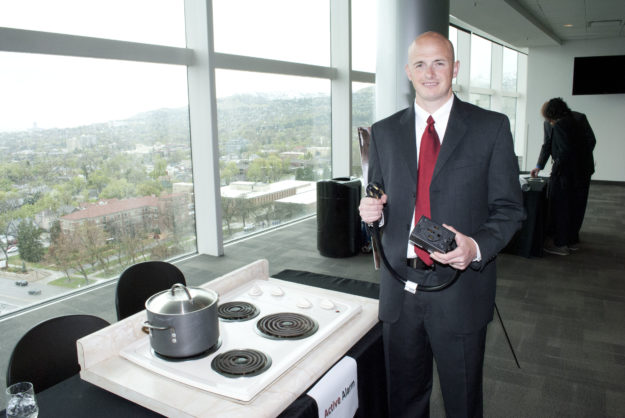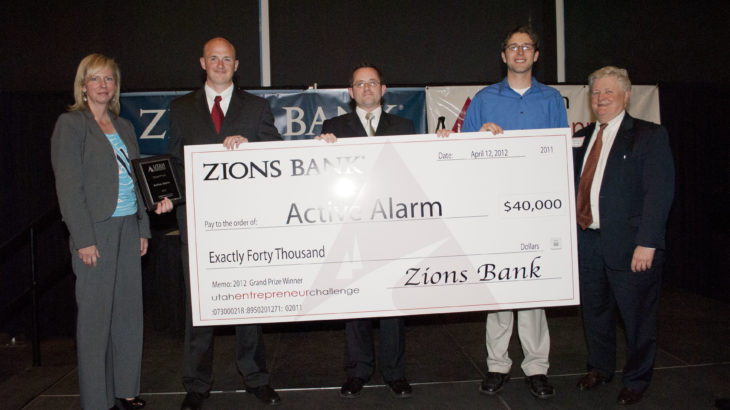The shrill warning of a smoke alarm has always signaled danger — yet a new device detects the alarm and shuts off power to the stove, successfully eliminating a fire threat. That invention and the student team behind it, called Active Alarm, earned the grand prize and $40,000 in this year’s Utah Entrepreneur Challenge (UEC). The annual business plan competition is based at the University of Utah and open to university students across the state.
“Stove fires are the second-most common source of fire-related deaths,” said Peter Thorpe, a member of Active Alarm. Thorpe and his partners, Rhett Weller and Michael Sanders, are students at Brigham Young University.
Over 2,000 students competed in this year’s event, presenting ideas ranging from medical devices to bakeries. The event is hosted by the Pierre Lassonde Entrepreneur Center and the David Eccles School of Business, and sponsored by Zions Bank. $100,000 in cash and prizes are awarded at the event. Winners are evaluated on the quality of their invention or product and their strategy for selling it.

Active Alarm
Ligadon, a University of Utah team, won both Best Technology and Best Written Business Plan. Ligadon provides an alternative to the predominant suture method used for ligament and tendon tears, reducing the risk of a repeat injury. Creator Dolly Holt says you never know how a business idea is going to be received: “You just go for it. You never think your idea is that good, but then it gets validated by professional judges and mentors … suddenly, you realize you might have something revolutionary.”
Power Practical, a Utah Valley University team, won the Best Presentation Award with its Power Pot. The device combines a heat source and water in a cooking pot to create electricity that can then be used to charge USB devices.
Other finalist ideas included a virtual ID badge designed to increase hospital security; a cervical dilation measurement device; ultrasonic frequency channeling for protein removal on contact lenses; and bed-sore prevention maneuvers using air bladders to shift pressure points. Also in the finals was Lithe Medical, which seeks to decrease spinal cord surgery time and FlexLeg that promoted an artificial leg in place of a crutch for amputees.
Winners of the UEC receive not only prize money, but consultative services, professional feedback and network connections to aid in the implementation of their business plans. Many of the business plan ideas have taken years of research, development, and thought, and the effort is visible.
“Our Zions Bank associates have enjoyed interacting with these student visionaries through educational conferences, forums and networking opportunities,” said Scott Anderson, President and CEO of Zions Bank. “The Utah Entrepreneur Series has proven to be a win-win opportunity for both our business community and student participants.”
The UEC is the third and final competition in the Utah Entrepreneur Series. Many UEC entrants took advantage of the first two competitions in the series: techTITANS and Opportunity Quest.
“This process is so beneficial because it has so many real-world applications,” said Jeff Ehlers, of the Lithe Medical team. “We’ve had some great mentors who offered many perspectives to help us refine our product and vision. Speaking to the judges also has been an ideal practice run for pitching our company to investors.”
For more information about the Utah Entrepreneur Challenge or the Utah Entrepreneur Series, visit www.ues.utah.edu.
2011-12 Finalists
Active Alarm – Creates products that prevent fires before they start. Its patented devices remove the energy source during the smoking phase before the fire ignites. Rhett Weller, Michael Sanders, Peter Thorpe (BYU).
CerviGauge – A monitoring system to quickly measure the progress of cervical dilation during a mother’s labor that has been developed by Umbrella Medical Technologies, an all-student medical device design company. This disposable device leverages innovative design characteristics to reduce the need for manual cervical exams, which reduces the risk of intra-amniotic infection for the mother and child. Tim Cosgrove, Andrew Pagels, Anthony Peterson, and Naresh Kumar (U of Utah).
EMRID Technologies – Allows web servers to turn mobile devices into virtual ID badges, replacing usernames and passwords to grant easy access to secure data. Currently the technology is in use at University Hospital and saves physicians up to 40 minutes a day. Austin Aerts, Emily Theisen, David Kent (U of Utah).
FlexLeg – A hands-free alternative to crutches that brings advances in prosthetic technology to a new market for those recovering from a temporary below-knee injury. Mike Sanchez, Seth Gonzalez, Mark Roberts (BYU).
HypeKick – A commerce platform within online banking. By leveraging data gleaned from credit and debit card transactions, businesses can target consumers with great precision and consumers can shop free from the noise of irrelevant ads or offers. Matt Bills, Jared Taggart (BYU).
Ligadon – Provides a simple and effective device for ligament and tendon recombination. Current techniques suture torn ends together, but high stress often tears the sutures through the tissue, causing pain, increased healing time and often requires repeat surgeries. Ligadon’s device is completely bioabsorbable and equally distributes tension, preventing the ligament/tendon from tearing under strain and thus eliminates current failure rates. Dolly Holt, Adam Eshenroder (U of Utah).
Lithe Medical – A novel guidance tool for decreasing the time it takes to implant spinal cord stimulators. Jeff Ehlers, Harikrishnan Jayamohan, Micah Frerck (U of Utah).
MediMatic – Changes the current approach to pressure ulcer (bedsores) prevention and management by providing an effective and inexpensive pressure-controlled garment called DermaShorts. Greg Liddiard, Hari Jayamohan, Keng-Min Lin, Rebecca Klaus (U of Utah).
Power Practical – Focuses on providing alternative personal power sources and efficient electronic devices, helping people take the first step toward a more energy independent and sustainable lifestyle. The PowerPot is a thermoelectric generator in the form of a cooking pot. Caleb Light, David Toledo (UVU).
SonicLenz – Uses a patent-pending process to restore contacts to a like-new condition. Contaminants on the contact lens cause eye irritation and infections. SonicLenz removes these contaminants, which other methods have been in the past been ineffective at removing. Andrew Flamm, Jake Allred (BYU).



